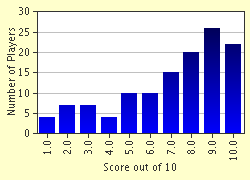Quiz Answer Key and Fun Facts
1. Akira Kurosawa began his film directing career during World War II under the Japanese war regime. His first directorial effort to be produced fully after the war brought him some notoriety overseas. This is a story about a young woman named Yukie whose father loses his job as a professor, and her boyfriend is executed for his political beliefs. What is the name of this film that is entitled 'Waga Seishun ni Kuinashi' in Japanese?
2. Arguably Kurosawa's first great masterpiece was the 1950 tale called 'Rash˘mon'. This film featured the same story told by four separate people, each of whom tell very different tales. Yet again, Kurosawa teams up with which actor, with whom he worked in sixteen different films?
3. Most film critics consider the 1954 classic 'The Seven Samurai' (Shichinin no Samurai) to be Kurosawa's greatest single work. The film has been remade several times in other countries, most notably in 1960 as 'The Magnificent Seven' by which American director?
4. Kurosawa was very keen on adapting the works of Western authors to the silver screen. Upon which Shakespeare play was Kurosawa's film 'Kumonosu J˘', aka 'Throne of Blood' based?
5. The 1958 film entitled 'Kakushi Toride no San Akunin', aka 'The Hidden Fortress', about two thieves who escort a princess across enemy lines on a mission they don't understand, inspired which of these exciting American films?
6. In 1960, Kurosawa created a very cynical view of Japanese corporate society with his film 'Warui Yatsu Hodo Yoku Nemuru'. What is the English title for this rather dark film?
7. In 1961, Kurosawa returned to samurai society in his filming of 'Yojimbo', the story of a samurai warrior who is hired as a bodyguard by two rival factions in a small village. This film inspired another classic film called 'A Fistful of Dollars' by Sergio Leone. Who was featured in the lead role in the Leone version?
8. Kurosawa's film career was long in decline by 1980, when he created the film 'Kagemusha'. Part of the reason that this film was able to be made relied on the fact that Kurosawa received funding support from two American directors. Which two directors supported this project as executive producers?
9. This 1985 film by Kurosawa was probably his grandest production, featuring amazingly filmed battle scenes. Roughly based on Shakespeare's 'King Lear', to which of the great Japanese film director's works do I refer?
10. One of the final films of Kurosawa's career was his haunting 'Yume', aka 'Dreams', from 1990. This surrealistic film featured an appearance by which Hollywood director as Vincent van Gogh?
Source: Author
thejazzkickazz
This quiz was reviewed by FunTrivia editor
skunkee before going online.
Any errors found in FunTrivia content are routinely corrected through our feedback system.

